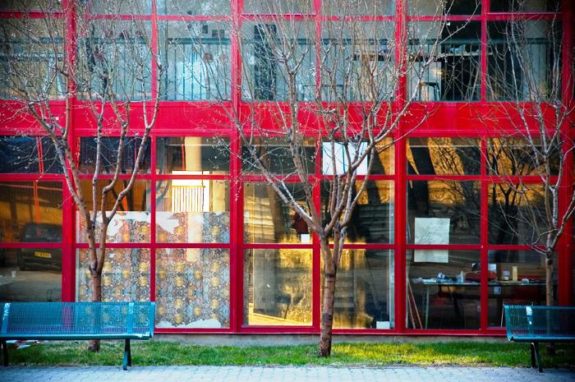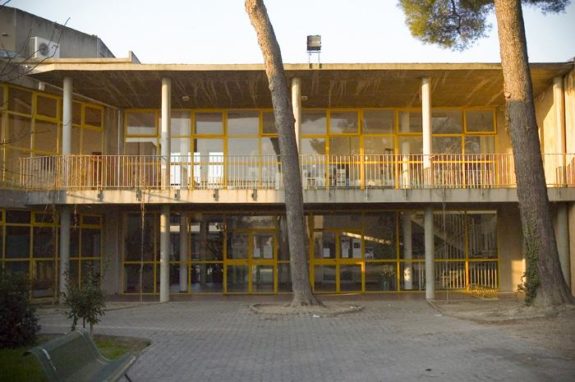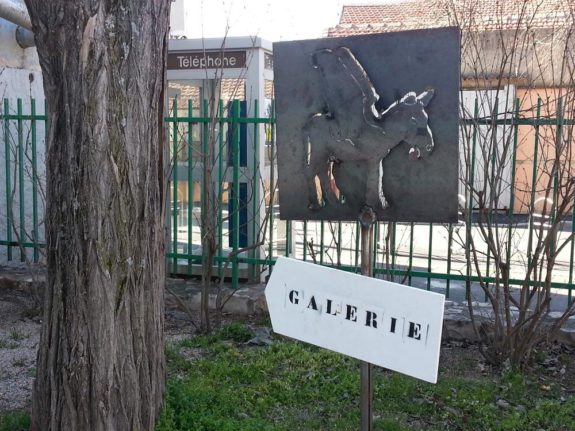The French Public Higher Schools of Art
Aix-en-Provence
École supérieure d’art d’Aix-en-Provence
about
The Higher School of Art of Aix en Provence is widely recognized in the field of “Digital Arts”, which it has developed over a number of years, and through its « Locus Sonus » research laboratory, a partnership with the National Higher School of Art, Bourges.
On January 1st, 2011, the town of Aix en Provence created, in collaboration with the state and the Communauté du Pays d’Aix, a Public Institution for Cultural Cooperation (EPCC) to meet European requirements pertaining to management and awarding of Masters grade qualifications (the Bologna Process). Having received an A grade from the Agency for the Evaluation of Research in Higher Education (AERES), the school furnishes a teaching of high quality based on a strong pedagogical project, allowing it to position itself on a European level. It has a strong policy encouraging international exchanges and is already working on research projects in association with other institutional partners (universities, research laboratories, etc.).




École supérieure d’art d'Aix-en-Provence
École supérieure d’art d'Aix-en-Provence
École supérieure d’art d'Aix-en-Provence
Galerie - École supérieure d’art d'Aix-en-Provence
options
Art
qualifications
DNSEP option Art
third cycle
Locus sonus
Locus Sonus is a 3rd cycle of the research type, specializing in audio creation research.
It unfolds in the form of a one-year session validated by a certificate of 3rd cycle of research in sound art (BAC+6). Locus Sonus is a research cycle common to the Higher School of Art of Aix en Provence and the National Higher School of Art of Bourges. On the horizon of this art orientated 3rd cycle is the opening up of cycles of art research programmes with a view to establishing the specific nature of art education.
The human and technical resources of both schools are pooled within the framework of a convention which permits both the optimum circulation and development of the initiatives of Locus Sonus concerning the DNSEP curriculum, and the basis for a cycle of research in art. The three axes of research in the programme are currently determined on the basis of three vectors (approach, collective, network), mixing two fields of practice and research (Audio and Spaces, Audio and Networks).
http://locusonus.org
accreditation of prior learning and experience
DNAP option Art
DNSEP option Art
research units
E-Topie (E-Topia)
E-Topia is a programme of thinking, exchange, experimentation and creation, a platform which has been structured progressively since 2010 and we would like it to be operational at the beginning of the 2013/2014 school year. It is equally a space for collaboration between different partners with complementary activities which allows this platform to be deployed both in and outside the school in different forms. E-topia is spread over five principal programmes: FRONTIERS of the 21st Century, MENTION A/RT, OBS’IN, LOCUS SONUS, DOCTORAT DE CREATION.
Locus Sonus – audio in art
Locus Sonus is a post graduate research laboratory in art, shared between the Higher School of Art of Aix en Provence and the National Higher School of Art of Bourges. It provides structure for the 3rd cycle of the E-topia programme, in particular through the CNRS/MCC framework agreement which has permitted cooperation with the MMSH and the IMéRA since 2007 on a local and international level.
This innovative and experimental project in the field of audio art is run in collaboration by the teachers Jérôme Joy (ENSA Bourges) and Peter Sinclair (ESA Aix en Provence). Its objective is to experiment with innovative and trans-disciplinary aspects of forms and artistic sound practices with regard to issues of spaces and networks. It exists in part to fulfill the mission of creating a corpus of knowledge and a critical space concerning practices in sound art which are currently in a period of evolution. The principal implementation of the laboratory concerns the transport of sounds (and atmospheres) giving rise to the construction of approaches to streaming and flow (live transmission of sound via internet) and to sensorial and experimental environments, playing with the interweaving of places and distances and the resulting modifications of perception that they generate.
The project welcomes a small number of postmasters researcher-artists who constitute, along with the permanent members, the research team. The artists develop projects which fall somewhere between their own concerns and those of the laboratory. Locus Sonus regularly publishes texts in international science publications and proposes a cycle of symposiums, workshops and pedagogical activities for schools each year.
For more information about Locus Sonus
For more information about the Esaaix site
research programmes
Doctorate in creation
On the request of its rapporteur, Jean-Raymond Fanlohe, the ESAAix has documented the creation of a new “Practice and Study of Artistic and Literary Creation” doctorate, adopted by the scientific council of the AMU (the University of Aix Marseille). The modes of accompanying questions of methodology concerning this new path for the thesis in addition to questions of co-direction are ongoing.
The ENSP of Arles also participates.
Frontiers of the 21st Century
Frontiers of the 21st Century is a trans-disciplinary and exploratory research programme by Cédric Parizot and was launched in September of 2011 in the IMéRA. Associating the ESAAix from the beginning, it brings together researchers from the social and natural sciences, artists and professionals (customs officers, industrialists…) to rethink the mutations of systems of control on state borders and their impact on spaces and populations.
Operating a real decompartmentalization between different fields, it constitutes a major tool for structuring the e-topia arts/sciences/technologies platform for research and creation, allowing for the modeling of the question of research in the ESAAix in a multidisciplinary convergence. The overlapping of approaches allows for experimentation of proto-form models of art/science/technology research and the invention of new forms of production pertaining to questions of edition and exhibition.
Mention A/RT
The A/rt mention, attached to the DNSEP art option, will be proposed to 2nd cycle students at the beginning of the first semester of 2013/2014. In this way, a student’s journey within the art option which has characterized an aspect of our teaching for a number of years, will be made explicit. This path requires the structuring of this platform in which it participates as a space for training and experimentation, while not excluding the other studios in the school. Transversality is at the very heart of our pedagogical practices.
Obs’in
Founder of the Obs/in, the Observatory for creative practices in digital imagery, with the National Higher School of Photography and the IUT of Digital Imagery (AMU-Arles), the specific contribution of the school is linked to the interwoven relationship between art, science and technology that the school has developed over a number of years, and more specifically in the permanent Art Temps Réel studio established in 2010.
publications
Publishing of artists’ books
activities and events
Exhibitions (School Gallery), conferences
Three annual themed weeks
Video Instants
The “tous courts” festival (programme of creative video)
post-curricular or extracurricular activities
Open studios: children, teenagers and adults. Fifteen or so propositions allowing amateurs to indulge in various media such as painting, drawing, photography and visual arts.
international cooperation
Interculturality is a fundamental element in the pedagogy of the school, from teachers to students, and also with guest participants and artists. The office for International relations coordinates the ensemble of international partnerships, in Europe and around the world, as well as the organization of student exchanges (a period of study or training elsewhere in 4th year).
The erasmus programme, grants for mobility and a complete list of partnerships on the schools website, in the École/Relations internationales section.
specific equipment
Foundational practices in art: wood, metal, volume, video, painting and drawing workshops
Image and publishing platform: photography, graphic design, computer graphics, screen printing (tracer, scanners, printers).
Real Time platform: robotics workshops, mecatronics (3D printer and digital milling machine), sound, 2D computing and hypermedia programming, virtual 3D.
Meta workshop.
The workshops are networked and connected to the internet.
A centre for documentation (an important stock of digital art).
networks
ANdEA, ELIA.
Festival GAMERZ., Résidences OHP (Observatoire de Haute Provence), GMEM, FRAC, Maison Numérique, AJMI
administrative team
Jean-Paul Ponthot Directeur
Dalia Messara Secrétaire Générale
Céline Marx Coordination pédagogique
Caroline Attard Secrétariat pédagogique
Julie Karsenty Relations internationales
Joël Belouet Communication et partnariats
Marie-Françoise Borel Bibliothèque
professors
Céline Ampelas
Jean-Marc Andrieu
Marc Aurelle
Antoine Bollasina
Alain Buttard
Alice Byrne
France Cadet
Carlos Casteleira
Blancard Christophe
Don Jacques Ciccolini
Laurent Costes
Remi Coupille
Jean Cristofol
Gonzague de Fos du Rau
Jacques Fournel
Ricardo Garcia
Stagnaro Guillaume
Hémery Jacques
Wilfried Legaud
François Lejault
Jean-Pierre Mandon
Paul-Emmanuel Odin
Marine Pages
François Parra
Sigrid Pawelke
Grégory Pignot
Josué Rauscher
Graeme Reid
Peter Sinclair
Guillaume Stagnaro
Douglas Edric Stanley
Jean-Paul Thibeau
Camille Videcoq
Robert Œuvrard
contact
Rue Émile Tavan
13100 | Aix-en-Provence
tél. +33 (0)4 42 91 88 70
fax +33 (0)4 42 91 88 69
secretariat@ecole-art-aix.fr
www.ecole-art-aix.fr